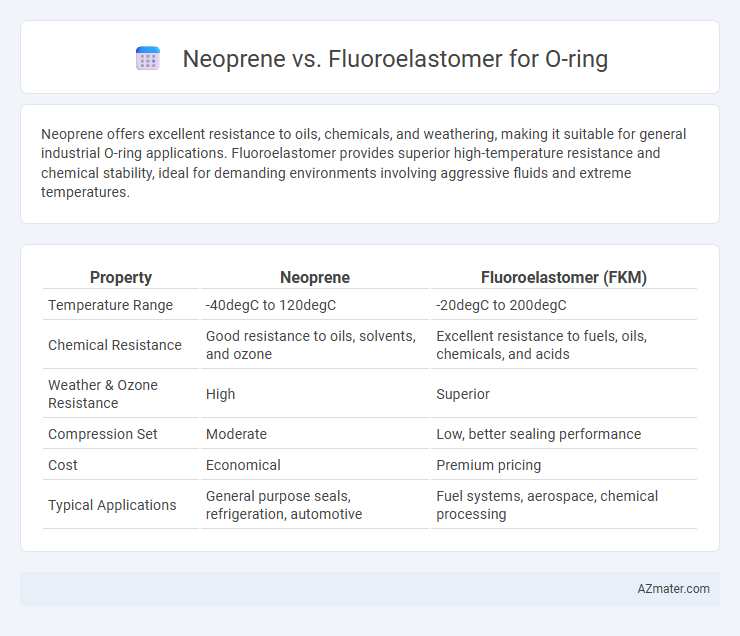Neoprene offers excellent resistance to oils, chemicals, and weathering, making it suitable for general industrial O-ring applications. Fluoroelastomer provides superior high-temperature resistance and chemical stability, ideal for demanding environments involving aggressive fluids and extreme temperatures.
Table of Comparison
| Property | Neoprene | Fluoroelastomer (FKM) |
|---|---|---|
| Temperature Range | -40degC to 120degC | -20degC to 200degC |
| Chemical Resistance | Good resistance to oils, solvents, and ozone | Excellent resistance to fuels, oils, chemicals, and acids |
| Weather & Ozone Resistance | High | Superior |
| Compression Set | Moderate | Low, better sealing performance |
| Cost | Economical | Premium pricing |
| Typical Applications | General purpose seals, refrigeration, automotive | Fuel systems, aerospace, chemical processing |
Introduction to O-Ring Materials
O-rings commonly use Neoprene and Fluoroelastomer due to their distinct chemical resistance and temperature tolerance. Neoprene offers excellent flexibility and moderate resistance to oils, ozone, and weathering, making it suitable for general-purpose sealing applications. Fluoroelastomer provides superior chemical resistance, high-temperature stability up to 200degC, and exceptional durability in harsh environments such as automotive and aerospace industries.
What is Neoprene?
Neoprene is a synthetic rubber known for its excellent resistance to oils, chemicals, and weathering, making it a popular choice for O-ring applications requiring durability and flexibility. It offers moderate temperature resistance, typically ranging from -40degC to 120degC, and provides good compression set retention. Neoprene's balanced chemical resistance and cost-effectiveness make it suitable for automotive, industrial, and refrigeration sealing solutions.
What is Fluoroelastomer (FKM)?
Fluoroelastomer (FKM) is a high-performance synthetic rubber known for its exceptional resistance to heat, chemicals, and oils, making it ideal for O-ring applications in harsh environments. Unlike Neoprene, FKM O-rings maintain flexibility and sealing integrity at temperatures up to 200-250degC, with superior resistance to fuels, solvents, and aggressive chemicals commonly found in automotive and aerospace industries. This chemical and thermal durability ensures longer service life and reliability in demanding sealing applications compared to Neoprene.
Key Properties of Neoprene O-Rings
Neoprene O-rings offer excellent resistance to abrasion, moderate chemical resistance, and good flexibility across a wide temperature range from -40degC to 120degC. These O-rings exhibit strong resistance to oils, greases, and weathering, making them suitable for automotive and industrial sealing applications. The material's durability, combined with its moderate cost, makes neoprene a versatile choice for general-purpose O-ring seals exposed to mild chemicals and environmental conditions.
Key Properties of Fluoroelastomer O-Rings
Fluoroelastomer O-rings exhibit superior chemical resistance, withstanding aggressive fuels, oils, and solvents, making them ideal for harsh industrial applications. These O-rings maintain excellent thermal stability, functioning effectively within a wide temperature range from -26degC to 230degC (-15degF to 446degF). Their low permeability to gases and outstanding compression set resistance ensure long-lasting sealing performance in demanding environments.
Chemical Resistance Comparison
Neoprene O-rings offer good resistance to oils, mild acids, and alkalis but degrade rapidly when exposed to strong solvents, hydrocarbons, and ketones. Fluoroelastomer O-rings provide superior chemical resistance, maintaining integrity against aggressive fuels, chemicals, and high-temperature fluids, including aromatic and aliphatic hydrocarbons. For applications requiring prolonged exposure to harsh chemicals, fluoroelastomer outperforms neoprene in durability and sealing reliability.
Temperature Resistance and Performance
Neoprene O-rings exhibit temperature resistance typically ranging from -40degC to 120degC, making them suitable for moderate thermal environments with good chemical stability and elasticity. Fluoroelastomer O-rings withstand much higher temperatures, often from -26degC up to 204degC or higher, providing superior resistance to extreme heat, aggressive chemicals, and oil-based fluids. The enhanced performance of fluoroelastomer in harsh thermal and chemical conditions makes it ideal for demanding applications requiring long-lasting sealing reliability.
Application Suitability: Neoprene vs Fluoroelastomer
Neoprene O-rings offer excellent oil, ozone, and weather resistance, making them ideal for automotive, refrigeration, and industrial applications involving moderate temperatures and exposure to water and chemicals. Fluoroelastomer O-rings provide superior chemical resistance, high-temperature tolerance up to 204degC (400degF), and exceptional durability in harsh environments such as aerospace, fuel systems, and chemical processing. Selection depends on application conditions with Neoprene favored for water and abrasion resistance, while Fluoroelastomer excels in aggressive chemical and high-heat scenarios.
Cost and Availability
Neoprene O-rings are generally more cost-effective due to their widespread production and availability, making them ideal for budget-conscious applications. Fluoroelastomer O-rings, while significantly more expensive, offer superior chemical resistance and durability but are less readily available, often requiring specialized suppliers. The choice depends on balancing upfront costs with long-term performance requirements in specific industrial environments.
Choosing the Right O-Ring Material for Your Needs
Neoprene O-rings offer excellent resistance to weathering, ozone, and moderate oils, making them ideal for general-purpose sealing in automotive and refrigeration applications. Fluoroelastomer O-rings provide superior chemical resistance, high-temperature stability, and durability in harsh environments such as fuel systems and aggressive chemical processing. Selecting the right O-ring material depends on the specific exposure conditions, temperature range, and chemical compatibility required for optimal sealing performance.

Infographic: Neoprene vs Fluoroelastomer for O-ring
 azmater.com
azmater.com